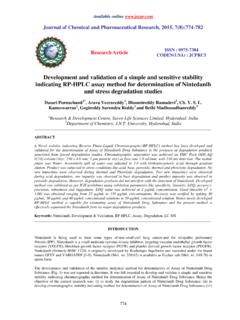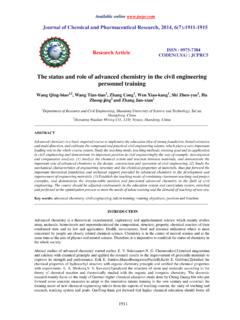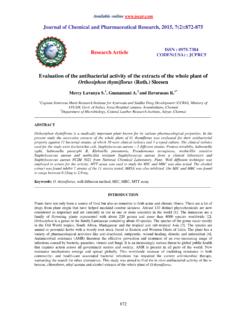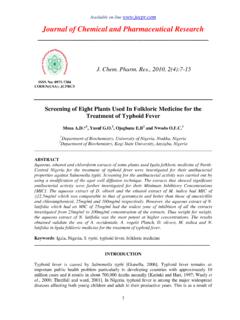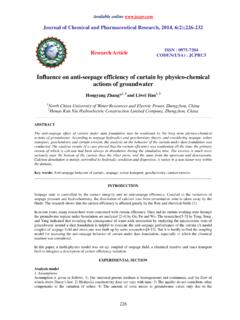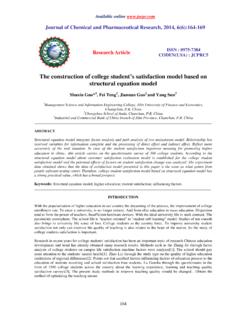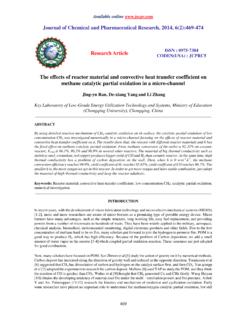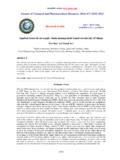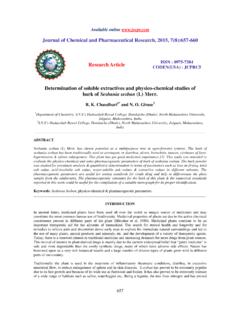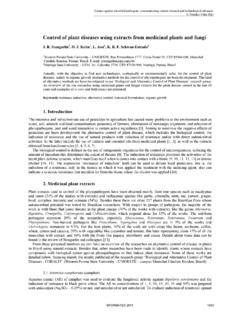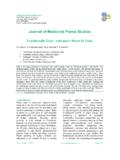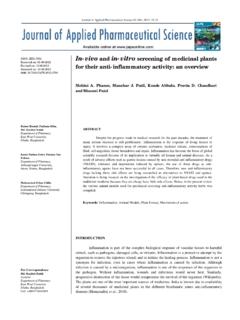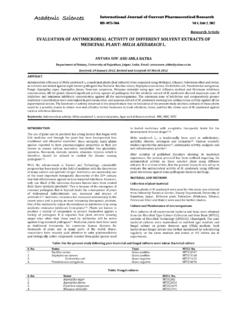Transcription of Review Article ISSN : 0975-7384 CODEN(USA) : …
1 Online Journal of Chemical and Pharmaceutical Research, 2015, 7(5):1050-1074 Review Article issn : 0975 - 7384 coden (USA) : JCPRC5 1050 Green technology: Economically and environmentally innovative methods for extraction of medicinal & aromatic plants (MAP) in Egypt Khaled A. Shams*, Nahla S. Abdel-Azim, Ibrahim A. Saleh, Mohamed-Elamir F. Hegazy, Mostafa M. El-Missiry and Faiza M. Hammouda National Research Centre, 33 El Bohouth st. (former El Tahrir st.), Dokki, Giza, Egypt _____ ABSTRACT Extraction process forms the first basic step in medicinal plant research because the preparation of crude extracts from plants is the starting point for the isolation and purification of chemical constituents present in plants. Yet the extraction step remains often a neglected area, which over the years has received much less attention and research.
2 Traditional methods of extraction and processing of herbs and medicinal plants such as solid liquid extraction (Soxhlet), steam distillation or cold press are still used in Egypt. These methods of extraction lack selectivity, give lower yields and because it uses large volume of organic solvents it present safety concern and environmental risk. Several new extraction techniques for improving efficiency and selectivity are now replacing the old methods of extraction. However, recently exports of medicinal and aromatic plants products from Egypt to other countries are becoming more and more restricted due to the presence of unacceptable levels of contaminants and occasionally the occurrences of heavy metals and pesticides that attributed to the drawbacks of traditional extraction methods.
3 The fact that one single plant can contain several secondary metabolites makes the need for the development of high performance and rapid extraction methods an absolute necessity. Keeping in pace with such requirements, recent times has witnessed the use and growth of new extraction techniques with shortened extraction time, reduced solvent consumption, increased pollution prevention concern and with special care for thermolabile constituents. Novel extraction methods including Microwave Assisted Extraction (MAE), Supercritical Fluid Extraction (SCFE), Accelerated Solvent Extraction (ASE), Subcritical Water Extraction (SWE) and Ultrasound Assisted Extraction (USE) have drawn significant research attention in the last decade. In this Review , we discussed the principles, affecting factors, advantages and disadvantages of traditional and innovative extraction techniques.
4 We also suggested some ideas to establish these innovative technologies for extraction in Egypt. Keywords: Innovative Green Techniques, Microwave Assisted Extraction (MAE), Supercritical Fluid Extraction (SCFE), Accelerated Solvent Extraction (ASE), Subcritical Water Extraction (SWE), Ultrasound Assisted Extraction (USE). _____ INTRODUCTION Medicinal plants have been used as a source of remedies since ancient times. The ancient Egyptians were familiar with many medicinal herbs and were aware of their usefulness in treatment of various diseases. The healing of sick persons was carried out by priest doctors who prescribed and prepared medicaments. The first recorded prescriptions were found in Ancient Egyptian tombs. The writing on the temple walls and in the papyri revealed that Ancient Egyptians used many herbal drugs for the same purposes as they are used today[1-4].
5 Medicinal plants and natural herb production and export from Egypt have been a major business and important source of income for many years. Among others; chamomile, fennel, anise, basil, peppermint and many other essential and fixed oils crops that are cultivated in Egypt have a very good reputation in the international markets. However, recent exports of these products from Egypt to other countries are becoming more and more restricted due Khaled A. Shams et al J. Chem. Pharm. Res., 2015, 7(5):1050-1074 _____ 1051 to the presence of unacceptable levels of contaminants and occasionally the occurrences of heavy metals and pesticides. Traditional methods of extraction and processing of herbs and medicinal plants such as solid liquid extraction (Soxhlet), steam distillation or cold press are still used in Egypt.
6 These methods of extraction lack selectivity, give lower yields and because it uses large volume of organic solvents it present safety concern and environmental risk. Several new extraction techniques for improving efficiency and selectivity are now replacing the old methods of extraction [5-7]. Plants have been the source of potential therapeutic agents ever since mankind has evolved. Although several active phytoconstituents and high activity profile drugs have been discovered from plants but the quality and safety related problems of herbal drugs have still been a challenge for researchers. The major reasons for these drawbacks are the lack of high performance, reliable extraction techniques and methodologies for establishing the purity and standard for herbal medicines [8, 9]. Due to these factors, the herbal medicines have still to find their way in order to be accepted in global market.
7 In research related to discovery of new active phytoconstituents, extraction is one of the important steps as it is the starting point for the isolation and purification procedures. An individual plant may consist of several active phytoconstituents existing in abundance along with certain constituents of low activity profile. Thus, there arises a need for the development of extraction and analysis techniques with high performance [10]. There has been a need for better and newer extraction techniques, in the herbal drug industry so that the extraction time and the cost of solvent consumption is decreased [11,12]. The traditional techniques of solvent extraction of plant materials are mostly based on the correct choice of solvents and the use of heat and/or agitation to increase the solubility of the desired compounds and to improve the mass transfer.
8 Usually the traditional techniques require longer extraction time thus running a severe risk of thermal degradation for most of the phyto-constituents [13]. Novel extraction methods including microwave assisted extraction (MAE), supercritical fluid extraction (SCFE), accelerated solvent extraction (ASE), Subcritical Water Extraction (SWE) and ultrasound assisted extraction (USE) have drawn significant research attention in the last decade [14]. If these techniques are explored scientifically, they can provide an efficient extraction technology for ensuring the quality of herbal medicines worldwide. For the past 126 years, Soxhlet extraction has been the most used among all other conventional techniques [13]. It serves a dual purpose of (a): extraction step for the isolation of phyto-constituents and (b): As a well established model for the comparison of new extraction alternatives.
9 One of the major significant shortcomings of Soxhlet extraction is the lengthy extraction time that can be 8, 16, and 24 hours or more, which results in consumption of considerable time and heat energy [15]. The lengthy time requirement makes it more labor-intensive and limits the number of samples that can be processed which may not be entertained from commercial aspects [16,17]. Use of large amount of organic solvents requires an additional recovery step and subsequent evaporation to concentrate the extract, resulting in more cumbersome process and also being detrimental to environment [13,18]. 1. An Overview of Extraction Techniques for Medicinal and Aromatic Plants: Some of the major constraints in sustainable industrial exploitation of medicinal and aromatic plants (MAPs)
10 Are due to the fact that the developing countries including Egypt have poor agricultural practices for MAPs, unscientific and indiscriminate gathering practices from the wild, poor postharvest and post-gathering practices leading to poor quality raw material, lack of research for the development of high-yielding varieties of MAPs, poor propagation methods, inefficient processing techniques, poor quality control procedures, lack of research on process and product development, difficulty in marketing, non-availability of trained personnel, lack of facilities and tools to fabricate equipment locally, and finally lack of access to the latest technologies and market information [19]. This calls for co-operation and coordination among various institutes and organizations of the region, in order to develop MAPs for sustainable commercial exploitation.
